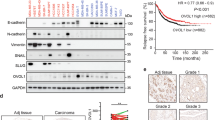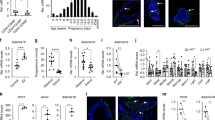Abstract
LIM-only protein 4 (LMO4) plays critical roles in mammalian development, and has been proposed to play roles in epithelial oncogenesis, including breast cancer. As LMO4 is highly expressed in the epithelial compartments at locations of active mesenchymal–epithelial interactions, we reasoned that LMO4 might act by modulating signaling pathways involved in mesenchymal–epithelial signaling. One such candidate signal is the transforming growth factor-β (TGFβ) cytokine pathway, which plays important roles both in development and cancer. We show here that the transcriptional response to TGFβ in epithelial cells is sensitive to LMO4 levels; both up- and downregulation of LMO4 can enhance TGFβ signaling as assessed by a TGFβ-responsive reporter gene. Furthermore, LMO4 can interact with the MH1 and linker domains of receptor-mediated Smad proteins, and associate with the endogenous TGFβ-responsive Plasminogen Activator Inhibitor-1 gene promoter in a TGFβ-dependent manner, suggesting that such interactions may mediate the effects of LMO4 on TGFβ signaling. When introduced into mammary epithelial cells, LMO4 potentiated the growth-inhibitory effects of TGFβ in those cells. These results define a new function for LMO4 as a coactivator in TGFβ signaling, and provide a potential novel mechanism for LMO4-mediated regulation in development and oncogenesis.
This is a preview of subscription content, access via your institution
Access options
Subscribe to this journal
Receive 50 print issues and online access
$259.00 per year
only $5.18 per issue
Buy this article
- Purchase on Springer Link
- Instant access to full article PDF
Prices may be subject to local taxes which are calculated during checkout







Similar content being viewed by others
Accession codes
References
Agulnick AD, Taira M, Breen JJ, Tanaka T, Dawid IB, Westphal H . (1996). Nature 384: 270–272.
Aoyama M, Ozaki T, Inuzuka H, Tomotsune D, Hirato J, Okamoto Y et al. (2005). Cancer Res 65: 4587–4597.
Arias AM . (2001). Cell 105: 425–431.
Bach I . (2000). Mech Dev 91: 5–17.
Bach I, Carriere C, Ostendorff HP, Andersen B, Rosenfeld MG . (1997). Genes Dev 11: 1370–1380.
Bach I, Rodriguez-Esteban C, Carriere C, Bhushan A, Krones A, Rose DW et al. (1999). Nat Genet 22: 394–399.
Berk M, Desai SY, Heyman HC, Colmenares C . (1997). Genes Dev 11: 2029–2039.
Chang H, Huylebroeck D, Verschueren K, Guo Q, Matzuk MM, Zwijsen A . (1999). Development 126: 1631–1642.
Chen YG, Liu F, Massague J . (1997). EMBO J 16: 3866–3876.
Colland F, Jacq X, Trouplin V, Mougin C, Groizeleau C, Hamburger A et al. (2004). Genome Res 14: 1324–1332.
de la Calle-Mustienes E, Lu Z, Cortes M, Andersen B, Modolell J, Gomez-Skarmeta JL . (2003). Dev Biol 264: 564–581.
Dennler S, Itoh S, Vivien D, ten Dijke P, Huet S, Gauthier JM . (1998). EMBO J 17: 3091–3100.
Derynck R, Akhurst RJ, Balmain A . (2001). Nat Genet 29: 117–129.
Derynck R, Zhang YE . (2003). Nature 425: 577–584.
Dong-Le Bourhis X, Lambrecht V, Boilly B . (1998). Br J Cancer 77: 396–403.
Grutz G, Forster A, Rabbitts TH . (1998). Oncogene 17: 2799–2803.
Hahm K, Sum EY, Fujiwara Y, Lindeman GJ, Visvader JE, Orkin SH . (2004). Mol Cell Biol 24: 2074–2082.
Hata A, Lo RS, Wotton D, Lagna G, Massague J . (1997). Nature 388: 82–87.
Hermanson O, Sugihara TM, Andersen B . (1999). Cell Mol Biol (Noisy-le-grand) 45: 677–686.
Hinks GL, Shah B, French SJ, Campos LS, Staley K, Hughes J et al. (1997). J Neurosci 17: 5549–5559.
Jurata LW, Kenny DA, Gill GN . (1996). Proc Natl Acad Sci USA 93: 11693–11698.
Kenny DA, Jurata LW, Saga Y, Gill GN . (1998). Proc Natl Acad Sci USA 95: 11257–11262.
Kudryavtseva EI, Sugihara TM, Wang N, Lasso RJ, Gudnason JF, Lipkin SM et al. (2003). Dev Dyn 226: 604–617.
Kurisaki K, Kurisaki A, Valcourt U, Terentiev AA, Pardali K, Ten Dijke P et al. (2003). Mol Cell Biol 23: 4494–4510.
Lee MKt, Moore DJ, Jarrett BP, Lian MM, Deng S, Huang X et al. (2004). J Immunol 172: 6539–6544.
Lee SK, Jurata LW, Nowak R, Lettieri K, Kenny DA, Pfaff SL et al. (2005). Mol Cell Neurosci 28: 205–214.
Lee SK, Pfaff SL . (2003). Neuron 38: 731–745.
Lin KK, Chudova D, Hatfield GW, Smyth P, Andersen B . (2004). Proc Natl Acad Sci USA 101: 15955–15960.
Luo G, Hofmann C, Bronckers AL, Sohocki M, Bradley A, Karsenty G . (1995). Genes Dev 9: 2808–2820.
Manetopoulos C, Hansson A, Karlsson J, Jonsson JI, Axelson H . (2003). Biochem Biophys Res Commun 307: 891–899.
Massague J, Wotton D . (2000). EMBO J 19: 1745–1754.
Matsuda K, Idezawa T, You XJ, Kothari NH, Fan H, Korc M . (2002). Cancer Res 62: 5611–5617.
Matthews JM, Visvader JE . (2003). EMBO Rep 4: 1132–1137.
McMahon JA, Takada S, Zimmerman LB, Fan CM, Harland RM, McMahon AP . (1998). Genes Dev 12: 1438–1452.
Milan M, Cohen SM . (1999). Mol Cell 4: 267–273.
Milan M, Cohen SM . (2000). Development 127: 3069–3078.
Milan M, Diaz-Benjumea FJ, Cohen SM . (1998). Genes Dev 12: 2912–2920.
Mizunuma H, Miyazawa J, Sanada K, Imai K . (2003). Br J Cancer 88: 1543–1548. (2: van Meyel DJ, et al. Ssdp proteins bind to LIM-int.[PMID:12642495]Related Articles, Links).
Mousses S, Bubendorf L, Wagner U, Hostetter G, Kononen J, Cornelison R et al. (2002). Cancer Res 62: 1256–1260.
Puig O, Caspary F, Rigaut G, Rutz B, Bouveret E, Bragado-Nilsson E et al. (2001). Methods 24: 218–229.
Rabbitts TH . (1998). Genes Dev 12: 2651–2657.
Racevskis J, Dill A, Sparano JA, Ruan H . (1999). Biochim Biophys Acta 1445: 148–153.
Ramain P, Khechumian R, Khechumian K, Arbogast N, Ackermann C, Heitzler P . (2000). Mol Cell 6: 781–790.
Sanford LP, Ormsby I, Gittenberger-de Groot AC, Sariola H, Friedman R, Boivin GP et al. (1997). Development 124: 2659–2670.
Sugihara TM, Bach I, Kioussi C, Rosenfeld MG, Andersen B . (1998). Proc Natl Acad Sci USA 95: 15418–15423.
Sugihara TM, Kudryavtseva EI, Kumar V, Horridge JJ, Andersen B . (2001). J Biol Chem 276: 33036–33044.
Sum EY, O'Reilly LA, Jonas N, Lindeman GJ, Visvader JE . (2005a). J Histochem Cytochem 53: 475–486.
Sum EY, Peng B, Yu X, Chen J, Byrne J, Lindeman GJ et al. (2002). J Biol Chem 277: 7849–7856.
Sum EY, Segara D, Duscio B, Bath ML, Field AS, Sutherland RL et al. (2005b). Proc Natl Acad Sci USA 102: 7659–7664.
Sum EY, Shackleton M, Hahm K, Thomas RM, O'Reilly LA, Wagner KU et al. (2005c). Oncogene 24: 4820–4828.
Thaler JP, Lee SK, Jurata LW, Gill GN, Pfaff SL . (2002). Cell 110: 237–249.
Torigoi E, Bennani-Baiti IM, Rosen C, Gonzalez K, Morcillo P, Ptashne M et al. (2000). Proc Natl Acad Sci USA 97: 2686–2691.
Tse E, Smith AJ, Hunt S, Lavenir I, Forster A, Warren AJ et al. (2004). Mol Cell Biol 24: 2063–2073.
van Meyel DJ, O'Keefe DD, Jurata LW, Thor S, Gill GN, Thomas JB . (1999). Mol Cell 4: 259–265.
Visvader JE, Mao X, Fujiwara Y, Hahm K, Orkin SH . (1997). Proc Natl Acad Sci USA 94: 13707–13712.
Visvader JE, Venter D, Hahm K, Santamaria M, Sum EY, O'Reilly L et al. (2001). Proc Natl Acad Sci USA 98: 14452–14457.
Wadman I, Li J, Bash RO, Forster A, Osada H, Rabbitts TH et al. (1994). EMBO J 13: 4831–4839.
Wadman IA, Osada H, Grutz GG, Agulnick AD, Westphal H, Forster A et al. (1997). EMBO J 16: 3145–3157.
Waite KA, Eng C . (2003). Nat Rev Genet 4: 763–773.
Wang N, Kudryavtseva E, Ch'en IL, McCormick J, Sugihara TM, Ruiz R et al. (2004). Oncogene 23: 1507–1513.
Wieser R, Wrana JL, Massague J . (1995). EMBO J 14: 2199–2208.
Yamada Y, Warren AJ, Dobson C, Forster A, Pannell R, Rabbitts TH . (1998). Proc Natl Acad Sci USA 95: 3890–3895.
Zeng C, Justice NJ, Abdelilah S, Chan YM, Jan LY, Jan YN . (1998). Proc Natl Acad Sci USA 95: 10637–10642.
Acknowledgements
We thank Yeguang Chen for the 9xCAGA-Luciferase construct; Jane Visvader for LMO4 antibody; Murray Korc for advice and reagents; and Steve Lipkin, Ping Wang, and Kevin Lin for reading the manuscript. This work was supported by National Institutes of Health Grant AR44882 (to BA), the Irving F Weinstein Foundation, the Breast Cancer Research Program of the United States Army Medical Research and Material Command (to BA, NW, and ZL), and the California Breast Cancer Research Program (to XX).
Author information
Authors and Affiliations
Corresponding author
Additional information
Supplementary Information accompanies the paper on Oncogene website (http://www.nature.com/onc).
Supplementary information
Rights and permissions
About this article
Cite this article
Lu, Z., Lam, K., Wang, N. et al. LMO4 can interact with Smad proteins and modulate transforming growth factor-β signaling in epithelial cells. Oncogene 25, 2920–2930 (2006). https://doi.org/10.1038/sj.onc.1209318
Received:
Revised:
Accepted:
Published:
Issue Date:
DOI: https://doi.org/10.1038/sj.onc.1209318
Keywords
This article is cited by
-
Evidence for the placenta-brain axis: multi-omic kernel aggregation predicts intellectual and social impairment in children born extremely preterm
Molecular Autism (2020)
-
The LIM-domain only protein 4 contributes to lung epithelial cell proliferation but is not essential for tumor progression
Respiratory Research (2015)
-
EZH2-Induced H3K27me3 is Associated with Epigenetic Repression of the ARHI Tumor-Suppressor Gene in Ovarian Cancer
Cell Biochemistry and Biophysics (2015)
-
JMJD2A contributes to breast cancer progression through transcriptional repression of the tumor suppressor ARHI
Breast Cancer Research (2014)
-
LIM-domain-only proteins: multifunctional nuclear transcription coregulators that interacts with diverse proteins
Molecular Biology Reports (2014)



